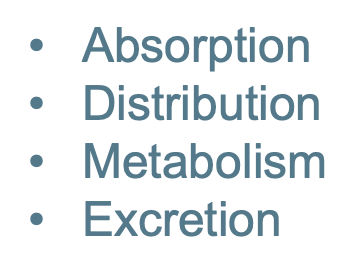Pharmacogeriatrics GERO495
1/23
There's no tags or description
Looks like no tags are added yet.
Name | Mastery | Learn | Test | Matching | Spaced |
|---|
No study sessions yet.
24 Terms
is the study of how the body interacts with administered substances for the entire duration of exposure

Pharmacokinetics
The four main parameters generally examined in pharmacokinetics are:

•Absorption
•Distribution
•Metabolism
•Excretion

is the study of a drug's molecular, biochemical, and physiologic effects or actions.

Pharmacodynamics

Distribution
Locations in the body a drug penetrates expressed as volume per weight (e.g. L/kg)

Bioavailability: the fraction of a drug dose reaching the systemic circulation

Absorption
Drug conversion to alternate compounds which may be pharmacologically active or inactive

Metabolism

Elimination

A drug’s final route(s) of exit from the body expressed in terms of half-life or clearance

Absorption is the process that brings a drug from the administration, e.g., tablet or capsule, into the systemic circulation.

Absorption
Metabolic clearance of drugs by the liver may be reduced due to:
•Decreased hepatic blood flow
•Decreased liver size and mass
•Changes in liver structure and metabolism
Excretion

•Excretion is the process by which the drug is eliminated from the body.
•The kidneys play a crucial role in the elimination of drugs

•Decreased kidney size Decreased renal bloodflow
•Decreased number of functional nephrons Decreased tubular secretion
•Result:glomerular filtration rate (GFR)
•
•Decreased drug clearance: atenolol, gabapentin, H2 blockers, digoxin, allopurinol, quinolones

Effects of Aging on Kidney
•Time for serum concentration of drug to decline by 50% (expressed in hours)
Half-life
•The volume of serum from which the drug is removed per unit of time (mL/min or L/hr)
Reduced elimination ⇒ drug accumulation and toxicity

Clearance
•Review medications regularly and each time anew medication started, or dose is changed
•
•Maintain accurate medication records (include vitamins, OTCs, and herbals)
•
•“Brown-bag reviews”
Preventing Polypharmacy